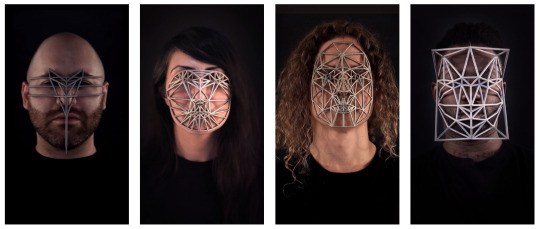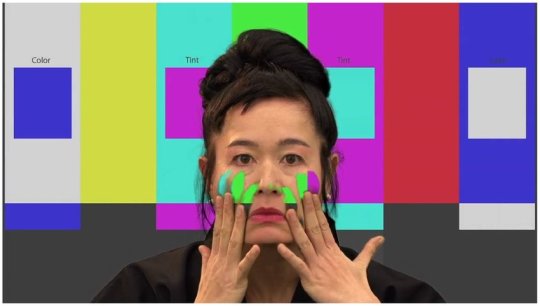Don't wanna be here? Send us removal request.
Text
instagram
0 notes
Text
instagram
1 note
·
View note
Text
ANALYSIS of Face Cages
Denada Permatasari. 1 September 2017.

Fig 1. Zach Blas’ Face Cages, exhibited at the Institute of Contemporary Arts Singapore, Gallery 1. 29 July - 22 October 2017.
I visited Gallery 1 at B1 on LASALLE College of the Arts, Singapore and I was immediately drawn to Zach Blas’ Face Cages exhibition.
The exhibit contains four 113.7 x 64 cm screens displayed in portrait mode, with each screen presenting a twelve-minute video of people wearing different masks. The screens have the distance of 93 cm between them. At the front of the screens there are the original masks that were worn by the subjects, not remakes. The plain black background behind the screens and the contrasting white lights illuminating the masks gives off a very polished and technologically-savvy vibes of the exhibition, even when the placement of the exhibition is not at the front of center of the gallery.
The face masks are 3D-printed with stainless steel as their material, and the polygonal patterns are from the subjects’ own biometric data from facial recognition scans. They are symmetrical and express a progression from barely a mask until a mask so wide it goes beyond the just the face. The material’s strength and durability is a symbol of oppression that is everlasting, while the progression shows the growth of imprisonment that steadily gets worse overtime.
Face Cages is the title of the series and I think the title is self-explanatory. At first glance, I understood immediately what the series is about. It’s about not being able to express our true selves, and that we are trapped within our own selves. But after further study I found out that the artwork carries a more nuanced meaning.
First, I learned that the artist who made them, Zach Blas, is a gay man. The rest of the subjects also belong to the LGBT community. Aside from Blas, they are also racial minorities (non-Caucasian). The fact that the subjects wearing the masks are minorities of minorities makes this series a bold political statement: “We, (referring to Blas et al. as representatives) the minority, suffer greatly.”
To give this series even further context, “Zach Blas is an artist and writer whose practice confronts technologies of surveillance, security and control with minoritarian politics.” (Blas) The masks do not fit the subject’s faces and in doing so, it is an “endurance performance” as it is very painful to wear them. I can confidently say that this is an analogy of the minority struggle, in which they suffer until they can’t anymore (implying rebellion and or suicide).
From the start of the 2010s, especially up until the mid-2010s, the LGBT discourse is reaching its all-time high, with notable moments such as the USA legalising same-sex marriage country-wide in June 2015 and the suicide of Leelah Alcorn, a transgender teen, in December 2014, just to name a few. This series rightly belongs to the Contemporary Art genre, which has all the hallmarks of the genre: identity politics and incorporated technology (Kleiner 942).
Taking into account of today’s social and political context, this series is a plea for attention, a “dramatization of the abstract violence of the biometric diagram.” (Blas) When I read that, I disagreed with the description as ‘violence’ is a strong and specific word, but upon more research I discovered that it is about literal violence; countries all over the world are implementing a nationwide biometric face scan for identification purposes, and people whose faces aren’t recognised will receive penalty and years in prison. (Blas)
At this point I realised that Face Cages is a literal title, not a metaphorical one. The revelation drives home at the gravity of systemic discrimination and violence inherent in a so-called 'objective’ algorithm that runs biometric scans, and that this invisible brutality is happening right under my nose. After viewing Face Cages and having knowledge of its context, I am grateful and impressed at Blas’ courage for speaking up through his art, to give the oppressed minorities a voice that can, and should be heard.
References
Blas, Zach. “Biography”. <www.zachblas.info/biography/>
Kleiner, Fred S. Gardner’s Art through the Ages. 14th edition. Wadsworth Publishing, 2012. Print.
Blas, Zach. “Face Cages”. <http://www.zachblas.info/works/face-cages/>
Blas, Zach. “Escaping the Face: Biometric Facial Recognition and the Facial Weaponization Suite”. Journal of the New Media Caucus. CAA Conference 2013 (2003). <http://median.newmediacaucus.org/caa-conference-edition-2013/escaping-the-face-biometric-facial-recognition-and-the-facial-weaponization-suite/>
#faciality#gillesdeleuze#felixguattari#biometric systems#facial recognition#politics#minorities#lgbtqia+#queer#seeing#thinking#technology#faces#labels#visibility#disappearance
2 notes
·
View notes
Text
instagram
0 notes
Photo

Building Conversation
#building conversation#art of conversation#philosophy#participatory art#participation#social engagement#theatre#performance#thinking#doing
0 notes
Photo




Digital sketches on identity, gender and expression
#portfolio#photoshop#digital art#self portrait#categorisation#labels#straight cis white man#safety mask#man#woman#person#non-binary#gender#identity
0 notes
Photo



Lorna Simpson
Combination Platter, 1992 | She, 1992 | Wigs, 1994
#lornasimpson#visual art#gender#race#categorisation#identity#dress#hair#labels#image bank#seeing#thinking
0 notes
Photo

0 notes
Photo

0 notes
Photo


“How Not To Be Seen: A Fucking Didactic Educational .MOV File” (Hito Steyerl 2013)
https://www.youtube.com/watch?v=LE3RlrVEyuo
#hitosteyerl#disappearance#politics#video essay#digital art#philosophy#the wretched of the screen#representation#resolution#virtuality#image bank#seeing#thinking#hearing
1 note
·
View note